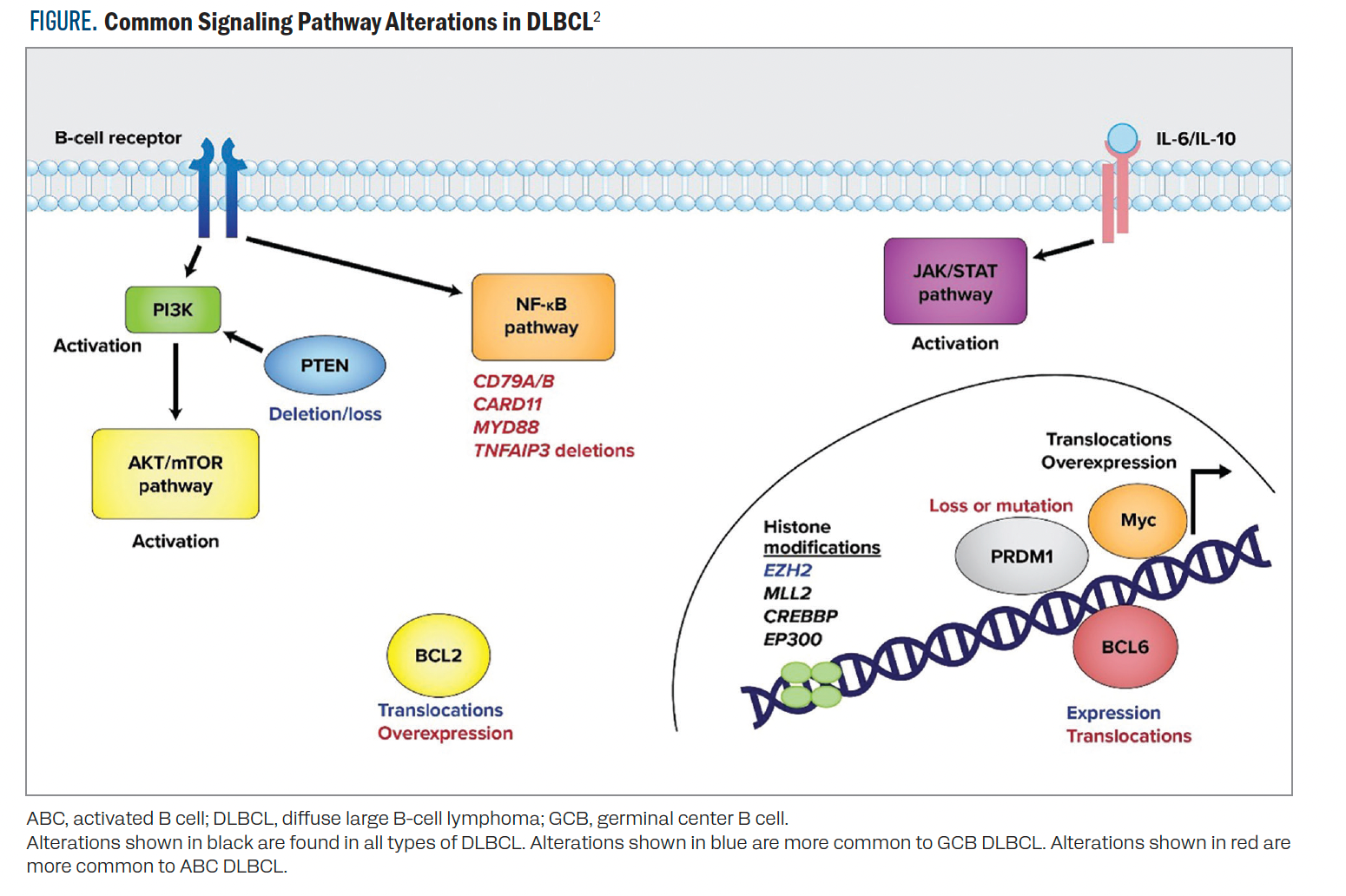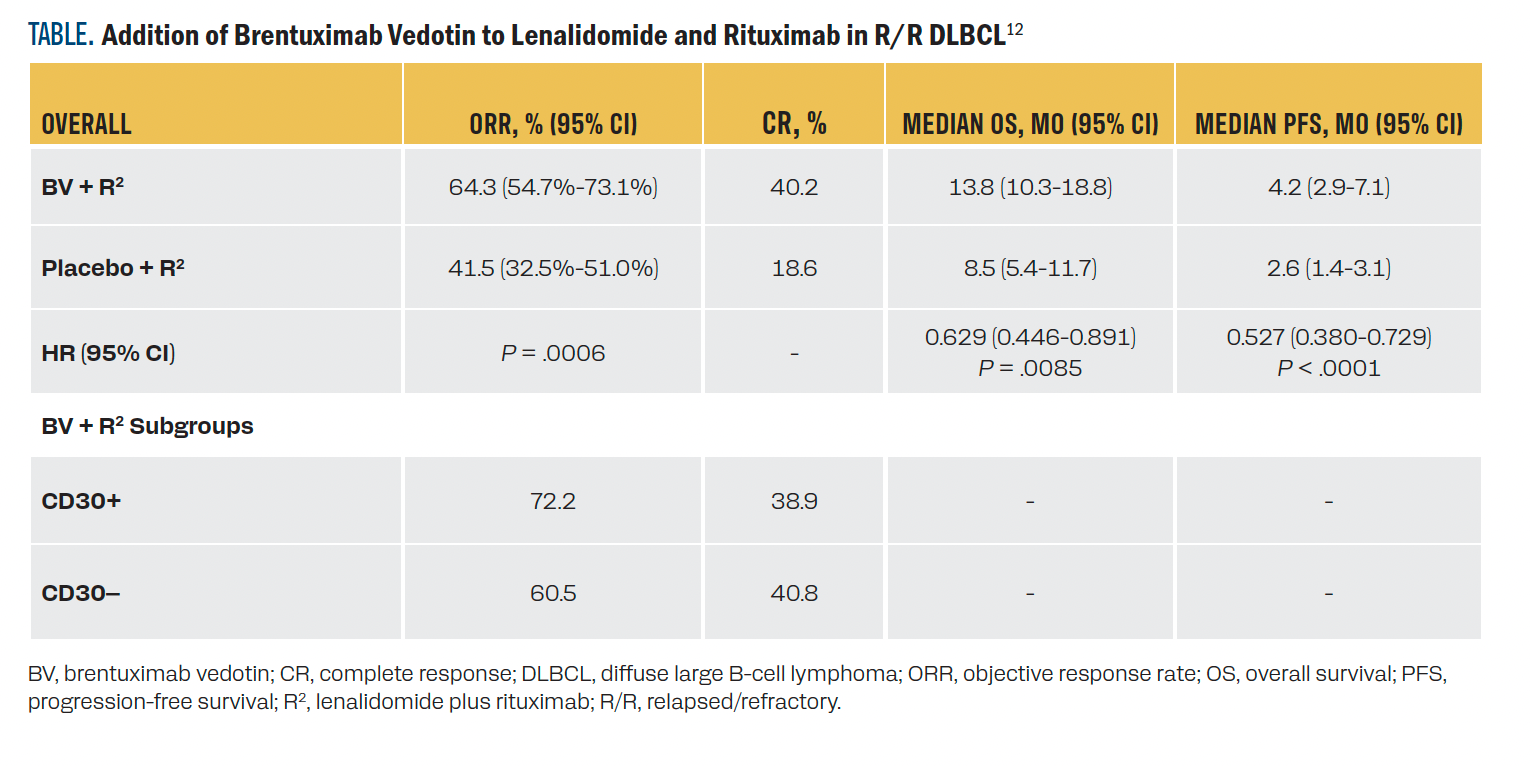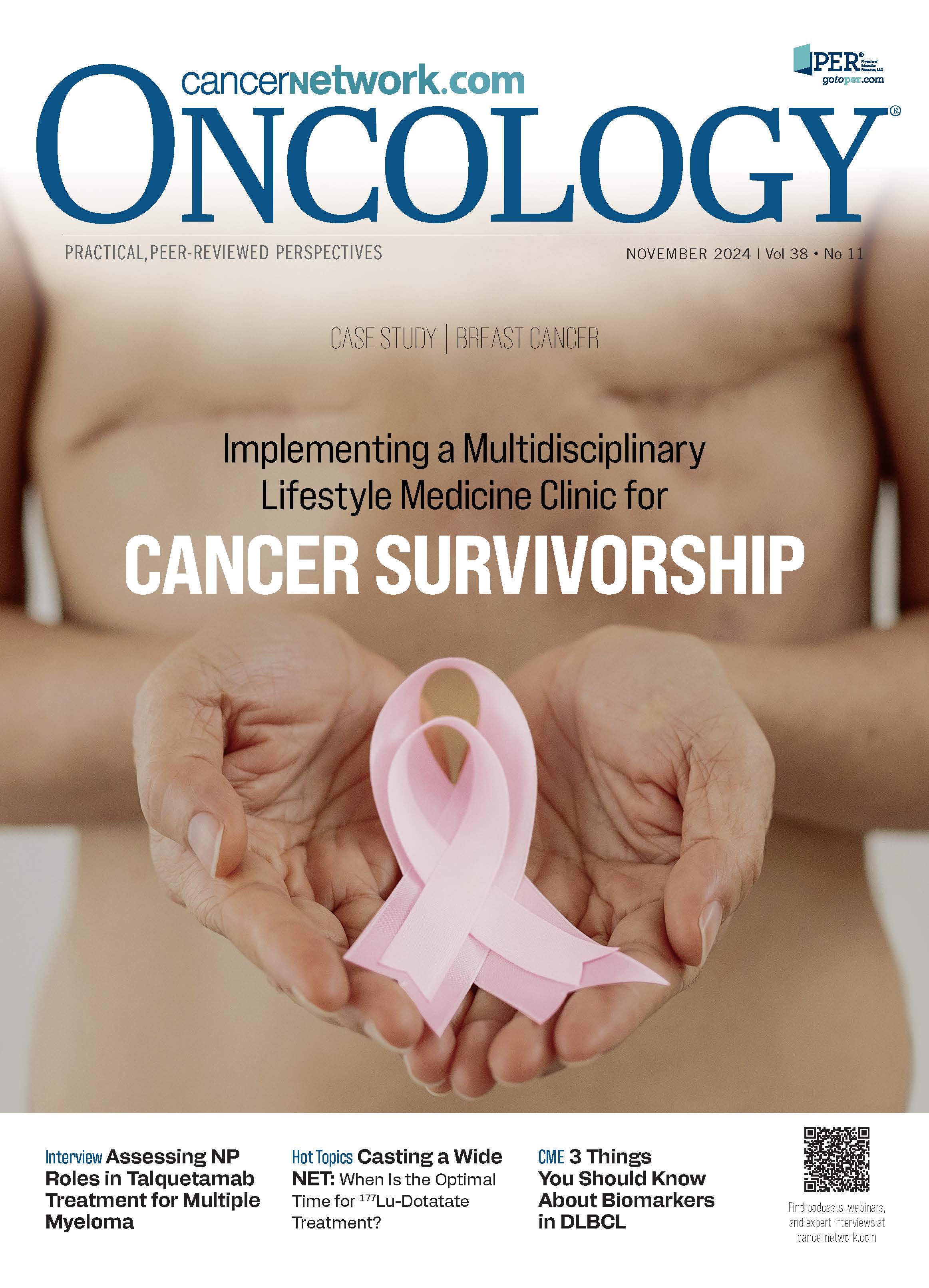3 Things You Should Know About Biomarkers in DLBCL
DLBCL is a genetically heterogeneous malignancy with multiple subtypes and recent investigations based on molecular profiles have opened the possibility for personalized therapy in this disease space.
Meet the experts

Diffuse large-B-cell lymphoma (DLBCL) is the most common subtype of non-Hodgkin lymphoma, comprising up to 40% of all newly diagnosed cases.1 DLBCL is a genetically heterogeneous malignancy with multiple subtypes and recent investigations based on molecular profiles have opened the possibility for personalized therapy in this disease space. Here are 3 things you should know about the use of biomarkers in DLBCL.
1 Biological heterogeneity appears to drive outcomes associated with standard treatment.
The 2 largest cell-of-origin (COO) subtypes arising from different stages of lymphoid differentiation, activated B cell (ABC) and germinal center B cell (GCB), comprise 50% and 30% of DLBCL cases, respectively.1 Although combination rituximab, cyclophosphamide, doxorubicin, vincristine, and prednisone (R-CHOP) therapy is curative in approximately 60% of patients, those who do not respond to R-CHOP often have dismal outcomes.2 Patients with the ABC subtype tend to be among those who experience poor outcomes, with a 3-year progression-free survival (PFS) following R-CHOP of 40% vs 75% in patients with GCB DLBCL (P < .001).3
Timely identification of patients’ COO subtypes can enable the creation of individualized treatment plans to promote optimal patient outcomes. With that goal in mind, the Lymphoma/Leukemia Molecular Profiling Project developed the Lymph2Cx assay, a digital gene expression (NanoString)–based test to assign COO using immunohistochemistry on formalin-fixed paraffin-
embedded tissue.4 This protocol uses less expensive tests on more readily available material than previous assays. Validation of the Lymph2Cx assay against the gold-standard gene expression profiling methods using a cohort of 20 genes resulted in Lymph2Cx correctly designating 57 of 58 cases (98%) as ABC, GCB, or unclassified (5%-7% of cases). COO classification using the Lymph2Cx method correlated strongly with patient outcomes. Patients with ABC DLBCL were more likely to experience disease progression than those with the GCB subtype (relative risk [RR], 3.6; 95% CI, 1.6-8.4; P < .001). When the same participants were classified according to the gold standard, the correlation was less strong (RR, 2.6; 95% CI, 1.1-6.3; P = .01).
Although the ABC and GCB subtypes share some targetable oncogenic pathways, they each also have unique genetic alterations that might indicate better efficacy of a drug in one subtype over the other (Figure).2 In a subgroup analysis of the phase 3 POLARIX trial (NCT03274492), the antibody-drug conjugate (ADC) polatuzumab vedotin combined with rituximab, cyclophosphamide, doxorubicin, and prednisone (pola-R-CHP) yielded better outcomes vs R-CHOP in patients with ABC DLBCL but not in patients with GCB DLBCL.5,6 In the overall population, the 2-year PFS rate was 76.7% (95% CI, 72.7%-80.8%) with pola-R-CHP vs 70.2% (95% CI, 65.8%-74.6%) with R-CHOP.5 However, the HR for disease progression, relapse, or death for pola-R-CHP vs R-CHOP was 0.34 (95% CI, 0.13-0.85) in the ABC subgroup vs 1.18 (95% CI, 0.75-1.84) in the GCB subgroup.6 Although the safety profiles of the 2 regimens were generally similar, the incidence of febrile neutropenia was higher among patients receiving pola-R-CHP vs R-CHOP (13.8% vs 8.0%). Therefore, R-CHOP might be the preferred regimen for patients with GCB DLBCL who appear to receive no benefit from pola-R-CHP.
FIGURE. Common Signaling Pathway Alterations in DLBCL2

2 Outcomes of patients with double-hit DLBCL are worse than for those with a single MYC or BCL2 aberration.
A minority of patients with DLBCL (10%) harbor both MYC gene rearrangements, and approximately half of them also harbor rearrangements in BCL2, BCL6, or both, conditions termed double-hit DLBCL (DHL) and triple-hit DLBCL (THL), respectively.1 These cases arise largely in the GCB subtype. Multiple retrospective studies suggest that patients with DHL have poorer outcomes with standard therapy. One analysis of 167 patients with DLBCL demonstrated that, relative to the overall population, those with DHL had reduced overall survival (OS) (HR, 3.2; P = .001).7
Higher-intensity chemoimmunotherapy may provide better outcomes than R-CHOP for patients with DHL. A single-arm, phase 2 study (NCT01092182) enrolled 53 patients with DLBCL, including 19 with MYC rearrangements and 24 with DHL to receive dose-adjusted etoposide, prednisone, vincristine, cyclophosphamide, doxorubicin, and rituximab (DA-EPOCH-R).8 The 48-month event-free survival (EFS) was 71.0% (95% CI, 56.5%-81.4%), and the 48-month OS was 76.7% (95% CI, 62.6%-86.1%). Grade 4 adverse events included neutropenia (53%) and thrombocytopenia (13%). Febrile neutropenia of any grade was reported in 19% of patients. Treatment-related death due to infection occurred in 3 patients. As a result of this study, DA-EPOCH-R became the preferred treatment for patients with DHL.
A subsequent retrospective study of 6412 patients with DLBCL, including 304 with DHL or THL, demonstrated that patients with DHL/THL who received R-EPOCH as first-line treatment (n = 131) had significantly improved OS (median not reached [NR]) vs those who received R-CHOP in the first line (n = 97; median OS, 20.2 months; 95% CI, 14.8 months to NR).9 Treatment with R-EPOCH resulted in a 50% lower risk of death (HR, 0.50; 95% CI, 0.33-0.77). There were no significant survival benefits for either regimen in patients without DHL/THL.
Based on the presence of BCL2 rearrangements in patients with DHL, the Alliance A051701 phase 2/3 study (NCT03984448) investigated the benefit of adding venetoclax to DA-EPOCH-R.10 There was no benefit to response rates, PFS, or OS with the addition of venetoclax compared with patients receiving only DA-EPOCH-R. Furthermore, 6 patients (17%) receiving venetoclax plus DA-EPOCH-R died during treatment due to sepsis (n = 4) or cardiac arrest (n = 2) vs 1 patient (3%) in the DA-EPOCH-R–only arm (due to Pneumocystis jirovecii pneumonia).
An alternative drug combination of cyclophosphamide, vincristine, doxorubicin, and high-dose methotrexate with ifosfamide, etoposide, high-dose cytarabine and rituximab (CODOX-M/IVAC-R) was compared with DA-EPOCH-R in a retrospective analysis of 113 patients younger than 60 years who had DHL/THL.11 Complete response was achieved by 80% of the 49 patients receiving CODOX-M/IVAC-R vs 58% of the 64 patients receiving DA-EPOCH-R. Additionally, treatment with CODOX-M/IVAC-R was associated with improved EFS vs DA-EPOCH-R (HR, 0.54; 95% CI, 0.31-0.97). However, there was no OS benefit.
3 ADCs may represent new options for patients with R/R DLBCL.
TABLE. Addition of Brentuximab Vedotin to Lenalidomide and Rituximab in R/R DLBCL12

Outcomes tend to be dismal for patients with relapsed/refractory (R/R) DLBCL. The ECHELON-3 trial (NCT04404283) investigated whether adding the anti-CD30 ADC brentuximab vedotin (BV) to lenalidomide plus rituximab (R2) could improve outcomes for patients with R/R DLBCL who were ineligible for transplant or chimeric antigen receptor (CAR) T-cell therapy.12 Results are outlined in the Table.12 Benefit with BV plus R2 was even seen in patients without high expression of CD30.
The search is ongoing for a curative therapy for patients who do not respond to R-CHOP; however, outcomes are steadily improving with novel therapy combinations.
References
- Nowakowski GS, Czuczman MS. ABC, GCB, and double-hit diffuse large B-cell lymphoma: does subtype make a difference in therapy selection? Am Soc Clin Oncol Educ Book. 2015:e449-57. doi:10.14694/EdBook_AM.2015.35.e449
- Sehn LH, Gascoyne RD. Diffuse large B-cell lymphoma: optimizing outcome in the context of clinical and biologic heterogeneity. Blood. 2015;125(1):22-32. doi:10.1182/blood-2014-05-577189
- Lenz G, Wright G, Dave SS, et al. Stromal gene signatures in large-B-cell lymphomas. N Engl J Med. 2008;359(22):2313-2323. doi:10.1056/NEJMoa0802885
- Scott DW, Wright GW, Williams PM, et al. Determining cell-of-origin subtypes of diffuse large B-cell lymphoma using gene expression in formalin-fixed paraffin-embedded tissue. Blood. 2014;123(8):1214-1217. doi:10.1182/blood-2013-11-536433
- Tilly H, Morschhauser F, Sehn LH, et al. Polatuzumab vedotin in previously untreated diffuse large B-cell lymphoma. N Engl J Med. 2022;386(4):351-363. doi:10.1056/NEJMoa2115304
- Palmer AC, Kurtz DM, Alizadeh AA. Cell-of-origin subtypes and therapeutic benefit from polatuzumab vedotin. N Engl J Med. 2023;389(8):764-766. doi:10.1056/NEJMc2306105
- Johnson NA, Slack GW, Savage KJ, et al. Concurrent expression of MYC and BCL2 in diffuse large B-cell lymphoma treated with rituximab plus cyclophosphamide, doxorubicin, vincristine, and prednisone. J Clin Oncol. 2012;30(28):3452-3459. doi:10.1200/jco.2011.41.0985
- Dunleavy K, Fanale MA, Abramson JS, et al. Dose-adjusted EPOCH-R (etoposide, prednisone, vincristine, cyclophosphamide, doxorubicin, and rituximab) in untreated aggressive diffuse large B-cell lymphoma with MYC rearrangement: a prospective, multicentre, single-arm phase 2 study. Lancet Haematol. 2018;5(12):e609-e617. doi:10.1016/s2352-3026(18)30177-7
- Goyal G, Magnusson T, Wang X, Roose J, Narkhede M, Seymour E. Modern, real-world patterns of care and clinical outcomes among patients with newly diagnosed diffuse large B-cell lymphoma with or without double/triple-hit status in the United States. Haematologica. 2023;108(4):1190-1195. doi:10.3324/haematol.2022.281461
- Abramson JS, Ruppert AS, Giri S, et al. Randomized phase II/III study of DA-EPOCH-R +/- venetoclax in previously untreated double hit lymphoma: initial results from Alliance A051701. Blood. 2021;138:523. doi:10.1182/blood-2021-151266
- Atallah-Yunes SA, Rees MJ, Witzig TE, et al. CODOX-M/IVAC-R versus DA-EPOCH-R in double/triple-hit large B cell lymphoma in patients ≤60 years. J Clin Oncol. 2024;42(suppl 16):7067. doi:10.1200/JCO.2024.42.16_suppl.7067
- Kim JA, Hahn U, Kim W-S, et al. Brentuximab vedotin in combination with lenalidomide and rituximab in patients with relapsed/refractory diffuse large B-cell lymphoma: results from the phase 3 ECHELON-3 study. J Clin Oncol. 2024;42(suppl 17):LBA7005. doi:10.1200/JCO.2024.42.17_suppl.LBA7005
RELEASE DATE: November 1, 2024
EXPIRATION DATE: November 1, 2025
LEARNING OBJECTIVES
Upon successful completion of this activity, you should be better prepared to:
- Identify current and emerging biomarkers that can inform clinical decision-making in patients with DLBCL
- Describe how results of biomarker testing can be used to determine targeted treatments for patients with DLBCL
Accreditation/Credit Designation
Physicians’ Education Resource, LLC is accredited by the Accreditation Council for Continuing Medical Education (ACCME) to provide continuing medical education for physicians. Physicians’ Education Resource, LLC designates this enduring material for a maximum of 0.25 AMA PRA Category 1 Credit™. Physicians should claim only the credit commensurate with the extent of their participation in the activity.
ACKNOWLEDGMENT of commercial support
This activity is supported by an educational grant from Pfizer, Inc.
Off-label disclosure/disclaimer
This activity may or may not discuss investigational, unapproved, or off-label use of drugs. Learners are advised to consult prescribing information for any products discussed. The information provided in this activity is for accredited continuing education purposes only and is not meant to substitute for the independent clinical judgment of a health care professional relative to diagnostic, treatment, or management options for a specific patient’s medical condition. The opinions expressed in the content are solely those of the individual faculty members and do not reflect those of PER or any company that provided commercial support for this activity.
Instructions for participation/how to receive credit
- Read this activity in its entirety.
- Go to https://www.gotoper.com/bdlbcl24etdio-postref to access and complete the posttest.
- Answer the evaluation questions.
- Request credit using the drop-down menu.
- YOU MAY IMMEDIATELY DOWNLOAD YOUR CERTIFICATE.

Highlighting Insights From the Marginal Zone Lymphoma Workshop
Clinicians outline the significance of the MZL Workshop, where a gathering of international experts in the field discussed updates in the disease state.